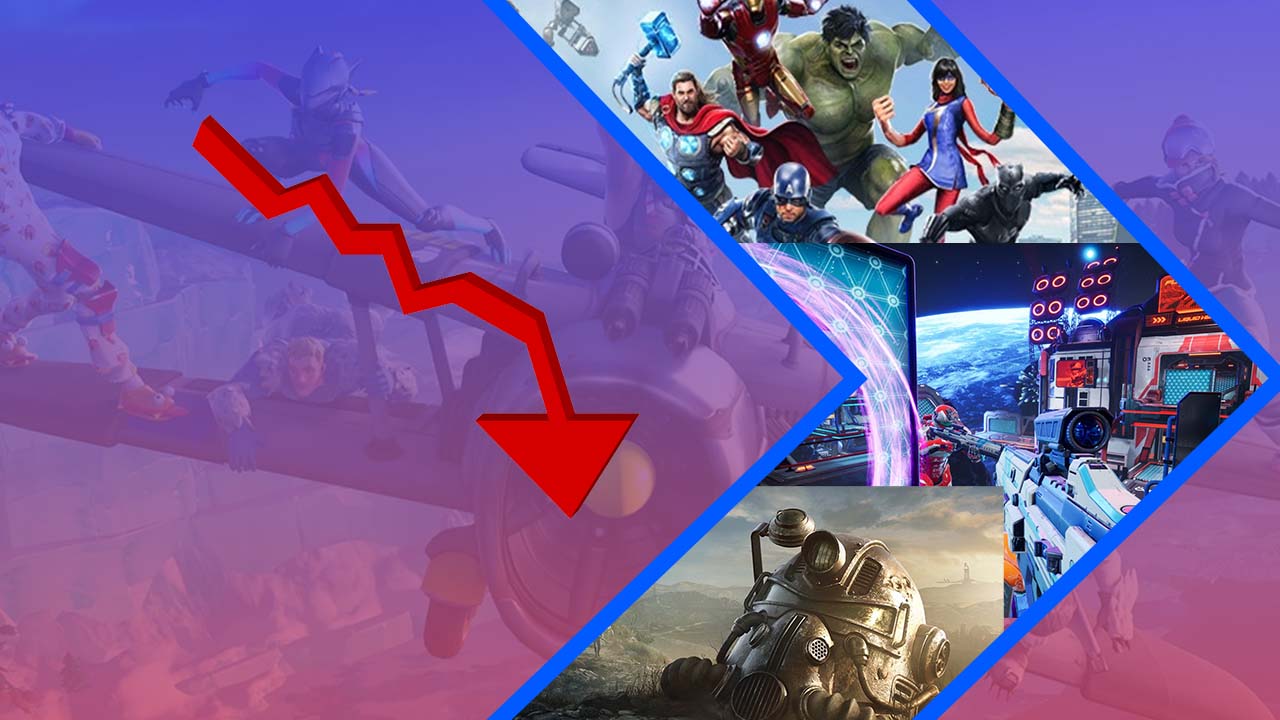Are you like me where you are sick and tired of playing the same game over and over again? Not sure if you have noticed but most games today are beginning to feel like a repeat of the game I spent $100 on microtransactions last year with only minor differences in updates and cosmetic changes to justify an endless grind? No longer entertainment but a grind. Thankfully there are the beginnings or a stir as gamers and critics are waking up to the fatigue of Live Service Games and beginning to question their value, appeal and impact they’re having on the industry as a whole.
Quick disclaimer, we promise this article isn’t because the Caiminds Team is salty that our favourite game, Splitgate is no longer receiving updates, despite spending so much money on Battle passes.

Live service games, are games designed to be continuously updated and monetized with microtransactions, expansions, and events over a long period of time, usually months or years. The goal is to create a sustainable revenue stream and a loyal fanbase that will keep playing and paying for the game long after its initial release. However, the reality is often very different, as live service games tend to suffer from a variety of problems that can turn off players and damage the reputation of the game and the developer.
One of the most recent and notorious examples of a live service game gone wrong is Marvel’s Avengers by Square Enix. The game, which was released in September 2020, promised to let players embody their favourite Avengers in a cinematic and epic adventure, with a story campaign, co-op missions, and post-launch updates featuring new heroes, villains, and challenges. However, the game failed to live up to its hype and expectations for several reasons.

First, the game suffered from technical and performance issues that plagued its launch and persisted for months, including bugs, glitches, crashes, and long loading times. These issues not only made the game unplayable for many players, but also exposed the lack of quality assurance and testing from the developer and the publisher. As a result, many players refunded the game or abandoned it after a few hours, leaving the player base small and fragmented.
Second, the game’s story campaign, which was supposed to be the main attraction of the game, turned out to be short, linear, and uninspiring. The plot, which revolved around an original villain and a generic threat, failed to capture the essence and appeal of the Marvel universe and its characters. The voice acting and animation, while featuring some famous actors, were often wooden and unconvincing, and the character designs and customization options were limited and shallow. As a result, many players felt that the game was a missed opportunity and a waste of their time and money.
Finally, the game’s live service features, which were supposed to keep the game fresh and engaging, turned out to be repetitive, grindy, and unbalanced. The game introduced new heroes and villains, such as Kate Bishop, Hawkeye, and Black Panther, but their stories and missions were short, recycled, and their gameplay mechanics and abilities were often broken or underwhelming. The game also introduced a gear system that allowed players to upgrade their characters with various stats and perks, but the system was confusing, random, and prone to exploits and hacks. The game also featured a store that sold cosmetic items and boosters for real money, but these items were criticized by many players as being way overpriced for what they were, especially considering you already spent money on a FULL PRICED RETAIL GAME.

As a result of these problems and others, Marvel’s Avengers quickly lost its momentum and its player base and its revenue and reputation suffered. Square Enix, the developer and publisher of the game, announced in May 2021 that it had incurred a loss of over $60 million due to the poor sales and reception of the game. The company also admitted that it had overestimated the demand for the game and the willingness of players to engage with its live service features. Square Enix also announced that it had to cancel several planned expansions and focus on fixing and improving the existing content, in order to salvage the game’s future and its brand image.
The damage however, had already been done. Marvel’s Avengers had become a cautionary tale of how live service games can backfire and harm not only the game itself, but also the industry as a whole. The game had consumed a large number of resources, time, and talent from Square Enix and its partners, such as Crystal Dynamics, Eidos Montreal, and Nixxes Software, and yet it had failed to deliver a satisfying and memorable experience for the players. The game had also alienated many fans and critics of the Marvel franchise, who felt that the game had betrayed the spirit and the lore of the characters and the stories.
The damage was so bad, it was rumoured this was the catalyst to Square Enix selling off their western studios to focus on their own original IPs.

But Marvel’s Avengers is just one example of many live service games that have suffered from similar problems and criticisms. Games such as Anthem, Fallout 76, Destiny 2, and Star Wars Battlefront II have also faced backlash and controversies for their lackluster content, technical issues, and predatory monetization practices. These games have also contributed to the perception that live service games are a risky and unreliable business model, and that they can erode the trust and loyalty of the players if they’re not executed properly and ethically.
So why are live service games bad for the video game industry? There are several reasons, and they’re not limited to the examples mentioned above.
First, live service games can stifle creativity and innovation, as they prioritize the monetization and the retention of the players over the quality and the originality of the content. Developers and publishers may focus on adding new skins, weapons, and events that appeal to the players’ vanity and FOMO, rather than creating new stories, mechanics, and worlds that challenge and inspire the players. This can lead to a stagnation and a homogenization of the industry, as many live service games tend to borrow and copy each other’s ideas and features.

Second, live service games can exploit and manipulate the players, especially the younger and more vulnerable ones, by using psychological tricks and addictive mechanics to encourage them to spend more time and money on the game. Many live service games use loot boxes, gacha mechanics, and time-gating to create a sense of uncertainty and urgency, and to lure the players into buying more virtual goods or currency. This can lead to a harmful and costly addiction, as well as to a loss of trust and respect between the players and the developers.
Third, live service games can divert resources and attention from other types of games, such as single-player games, story-driven games, and experimental games, that may not fit the live service model but still have artistic and cultural value. Many developers and publishers may choose to invest in live service games, simply because they’re seen as more profitable and sustainable, rather than taking risks and exploring new genres and ideas. This can lead to a lack of diversity and quality in the industry, as many players and critics may become disillusioned and bored with the same formulaic and repetitive games.

Live service games may seem like a good idea on paper, but in practice, they can have detrimental effects on the video game industry and its players. Games such as Marvel’s Avengers and even recently Warner Bros Games’ Multiverses, may serve as a wake-up call for the industry to reconsider the value and the ethics of the live service model, and to explore other ways of creating and enjoying games. As players and consumers, we should demand more from the games we play, and from the developers and publishers who make them. We should support games that are innovative, creative, and respectful of our time, money, and emotions, and we should speak up when we feel that our voices and our feedback are not being heard or valued. We should also educate ourselves and others on the risks and the benefits of different types of games and business models, and we should use our purchasing power and our social media influence to promote games that align with our values and our interests.
Ultimately, the success and the sustainability of the video game industry depend on the trust and the satisfaction of its players, and on the ability of its developers and publishers to balance creativity, innovation, and profitability. Live service games may have their place and their audience, but they should not be the only or the dominant form of games in the industry. As gamers and as human beings, we deserve better than just a never-ending cycle of grinding, paying, and waiting. We deserve games that inspire us, challenge us, and connect us with each other and with ourselves. Let’s make that a reality, one game at a time.





